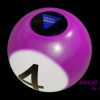Home › McC › Best Of...
Greetings!
Welcome to Scifi-Meshes.com! Click one of these buttons to join in on the fun.
McC
About
- Username
- McC
- Joined
- Visits
- 46
- Last Active
- Roles
- Member
- Points
- 373
- Posts
- 704
- Blender
- Blender
- GIMP
- GIMP
- Inkscape
- Inkscape
- Krita
- Krita
- Badges
- 8
-
U.S.S. Coronado, Katana Class Starship
Thanks, @psCargile !
Texture work continues.
Because it's come up several times when soliciting feedback, I should stress that the only (deliberate) texture on most of these is the flat color texture. I've pulled out the roughness and bump passes that I had on here before, as well as extracted out the metal color texture that I had mixed into the mess, as well. That's why the surface tends to look so much more bland than it has in prior renders; it's not indicative of a final look, but rather a stripped-down version aimed specifically at hammering out one particular kind of texture component. Even in just the color channel, I'm still planning to mix in some micro-paneling detail (see below for some experiments with this!), some procedural edge weathering, a general light scuff pass, and selectively mix how intense the actual color pass comes through.
Finished vectorizing my sketched-in panel lines from last time (Nov 14):

Vectorized the sketched-in texture detailing on the "notch" (Nov 15):

Spent some time experimenting with different configurations for what I want the blue accenting on the engineering hull to look like, finally settling on the below for the dorsal side. Also vectorized the top-side pylon texture (Nov 21):

Same, but on the ventral side of the engineering hull. This also shows some stuff I've been messing with for mixing world-projected "decals" into the texture for signage. I had previously been using a UV Project modifier and multiple UV channels to do this. What you see here is entirely in-shader, no extra UV layers required. Instead, I just use a non-rendering square plane scaled (this is important) to the desired size, and then fed through the shader via Texture Coordinate > Object, fed into a Mapping node, and then alpha-mixed ontop of the base color. There about half a dozen of these in the shader now. The banner itself is its own 4K texture, albeit not 4K on the vertical dimension (also Nov 21):

That night, I started thinking about how I might work in some procedural micro-paneling into the hull. While aztec paneling is probably Trek's most famous hull paneling, conventional aztec was less of a thing on the filming model of Enterprise-E and was also absent on the physical and digital models of Voyager, both of which have been my aesthetic touchstones for surface detail on this ship. Instead, one particular image stuck in my mind as a fascinating inspiration: the shot of Picard, Worf, and Hawk walking across the Enterprise-E saucer in First Contact. I pulled a selection of the hull out of the image and perspective-corrected it into a rectangle and have had this setting in my reference folder for a while as something to return to.


I spent a good chunk of yesterday messing around with how to do this procedurally. It started with a Manhattan-style voronoi texture and a bullheaded certainty that I could figure out how to create an "edge extract" effect entirely within Blender's shader nodes. Turned out that yes, indeed, I could!

The shader node for that is pretty large, but it's also fairly straightforward. Posted here, with annotations, for anyone interested in using a similar effect:

I took a crack at a first-pass implementation on Coro herself, with promising (if in desperate need of tweaking) results. I tried letting the voronoi component of the network use the actual UVs, which in hindsight was a mistake given the varied scale of the UVs (which the main texture UDIMs account for, but generated object coordinates would not). I also need to back off how strong the color variance is, and let the roughness -- which s not hooked up to this at all yet -- do most of the heavy lifting there. But on the whole, I was very happy with the initialy results of what started as a though experiment.

-
U.S.S. Coronado, Katana Class Starship
If you're just joining this thread, hi! Please read the first post for some background info. Many questions have come up over and over again that are answered there. Thanks!
Thanks, Brandenberg and evil_genius_180!
Managed to knock out the modeling of the dorsal shuttlebay over the course of the day today. Hooray for largely-reusable elements!



Terrible denoising artifacts on that one, but meh.


Noticed some pretty nasty old topology in that last render there around the panels just below the launchways, so I next set to work rebuilding those panels from denser, more evenly distributed curves. Got through 3 of the 5 before realizing it was probably time for bed!
-
U.S.S. Coronado, a Seven Year Mission
In January 2014, I posted Coronado's first exploratory WIP images. At the time, I said I aimed to be render-complete by August of that year. I...may have missed that target by a little. Completing this model has been a labor of love spanning over seven years. Not seven continuous years of working away at it. There were lots of long gaps where I didn't work on it at all. But, at last, I'm calling her done. Lots of background details available in the WIP thread (which I still need to make a final update post in!) for anybody curious.




-
U.S.S. Coronado, Katana Class Starship
Thanks, @JES!
Over the next several days, I spent a lot of time tweaking the various layer settings and mixes, never really finding something I was happy with. The following images are all from Nov 26th, representing different tweaks.






One persistent issue nagged the entire time: here was this radial saucer, with panels that didn't remotely conform to how it would have been built. If only I could convert Blender's automatically-generated UV coordinates into polar coordinates, the way one might with an image in a 2D editing program...which, I realized, is just a math problem. Of course, calling it "just" a math problem was a bit naive and it took days of fiddling to get the math to work the way I wanted to, in part because I feel like the "direction" I'm running the equation is backwards compared to what it "should" be...but that's the direction to run it to make the coordinates work. In any case, after lots of fiddling, I managed to achieve procedural polar UV coordinates for the saucer on Nov 29:


I'm going to write up a fairly in-depth post in the tutorials section on how I did this, in case it's useful to others.
Then I had to take a bit of a break from working on it, as we finally made live a fairly major system upgrade at work. I finally dove back in in the last couple of days, further refining both the panel layer mix and settings within itself (there are four distinct voronoi "mix" layers involved) and how that mixes in with the main hull shader. I also introduced a mask texture into the mix, which I can use to control the angle of the triplanar mapping for the panels on the pylons, while leaving the rest of the triplanar mapping unaffected, as well as desginate parts of the saucer to not be polar coordinates. In the prior images, I had been doing this purely based on UV coordinates (since all the saucer wedges are in UDIM 1002, so I could use the U range 2-3 as a "mask" as well). I'm pretty happy with the color mix at this point -- I think it has the right level of detail and level subtleness to achieve the effect I'm going for -- but the roughness mix still needs some work. Here's where we stand now:


-
U.S.S. Coronado, a Seven Year Mission
One @seanr requested on Discord (I'll see about doing some shaded area shots this evening!):

The bay interiors are unfinished right now, because I don't have any particular plans for them, but it shouldn't be too hard to finish them properly if I get the urge to do so. The black "tarmac" areas on both the Specter and upper bays are meant to extend into them, for reference; that jarring shift from dark to light is just a byproduct of the unfinished interior textures.
And @admiral horton's requested orthos:

-
U.S.S. Coronado, Katana Class Starship
I've spent the last several days making very little progress on textures and continuing to obsess over the hull shader. Discord quote of the year:
lewisniven wrote:2071, the grandchildren play with their hoverboards in the garden as grandpa McC further tweaks his hull shader
I keep finding things that are leftover -- or built in a way that's no longer valid based on my current approaches -- in my shader that are "corrupting" the look I expect to get out of it.
Since I had broadly homed in on the major material properties I wanted already, I finally felt comfortable following @Viper's suggested approach of dropping the ship into a color-corrected HDRI lighting environment, rather than space lighting, and adjusting material properties from there. The following images represent that shader exploration over the course of 1/29 to 2/1, with the last one having more-or-less finally achieved a look much closer to what I intended -- thanks in part to tweaking some settings based on this approach, but also thanks in large part to tearing the shader down to its constituent pieces and adding them all back together bit by bit, ensuring that everything was combining exactly as I intended and expected.






After that, I did a little rework on my textures themselves, mostly nudging colors around. In particular, I made the textured gridlines brighter than their underlying surface by a uniform amount across the whole ship, and I made the medium-gray armor panel lighter commensurate with the "off white" panel color's distance away from white, so the ratio between them is now the same. I finally shifted the escape pods away from their sandy color and to a more off-white/creamy color, as well.

I'm fairly happy with where this is now, though there are a handful of relatively small tweaks I already see that I need to make: reduce the bump depth on the panel lines and the panel line color on the dark "cape" (and possibly on the blue panels) is a little too dim to make out properly. Still, those are fairly small changes and I feel like I can finally move forward with further texturing work now. -
U.S.S. Coronado, Katana Class Starship
I next spent some time adding some much-neglected accent lighting around the ship, and retooling the way I had been handling my running lights. In particular, I was missing the white hotspot in the middle of the otherwise colored light, so I revised how my running light object was built in order to achieve that look. I also spent some time placing decals like the ship identifier and Starfleet pennants on the flanks of the stardrive and under the nacelles.



I moved on from there to finishing the last set of textured panel lines needed on the saucer wedges, which also prompted some rebalancing of my base metal "grunge" texture that feeds into the painted maps.

At last, it was time to tackle the nacelle textures.


About this time, I started to realize that my UV layout for the nacelles was garbage. Even with 4K maps, details painted into the texture were looking too low-res up close. The nacelle was also set at bit of an angle, which made all of the panel texture painting a giant pain. I set about completely re-UVing the main body of the nacelle, in the process switching it to use its own 4x2K texture instead of a 4K square texture that it shared with the Nebula-style sensor panels on the ventral saucer. With the nacelle now easier to work with, finishing it up happened fairly quickly.
Unfortunately, I ran into a hard limit in Blender/Cycles with my shader at this point -- it had grown too deep to render anymore, and was showing up all black. I decided at this point to "bake out" a large 4K image of my micropanels, rather than rely on them being entirely procedural (which required quite a few nodes). I'd still keep the procedural conversion between triplanar and polar coordinates, but there was no need to keep the four distinct Voronoi procedural texture networks that comprised the layers of micropanels at this point -- I hadn't tweaked those particular settings in quite some time. This also gave me a chance to simplify my math a little bit, which has had a very welcome impact on shader compilation time in the viewport, and even some impact on Cycles render time.


I next spent some time rebuilding the procedural shader on my warp nacelle grilles, aiming to get a better lighting result while still remaining fairly true to the Sovereign-style nacelles that are their inspiration. This involved a little bit of rethinking, switching from using stretched Checker textures to simply using some sine math on the UV map itself to determine the masked-out bands where the dark copper nacelle spacers would be and the gradual dark-to-light fade for the emission surface. I can also turn the emission of entirely, which results in a sort of flat, dull gray surface that matches what you might see of the ship when it's powered down.

Hull shader work, it seems, is never done. As I worked on finishing the panel lines on the flanks and spine of the ship, I continued fiddling with the color, roughness, and bump mix for the micropanels. One major "advance" here was better parameterizing my polar coordinate conversion node group so that I could independently control the latitudinal and longitudinal scaling of the texture; previously, they had been directly linked, which resulted in major stretching on the rim of the saucer. I further mixed in some slight perturbation in the IOR/Specular value informed by the micropanels, still centered on an IOR of 1.585, but fluctuating between 1.5 and 1.67 now.


The second image here can be directly compared with the similar image from two paragraphs back to see the changes in glossy reflections, color mix, and tiling.
I remain unsatisfied with total shader result, though; it continues to look "too CG" to me in most renders, which is frustrating.
-
U.S.S. Coronado, Katana Class Starship
If you're just joining this thread, hi! Please read the first post for some background info. Many questions have come up over and over again that are answered there. Thanks!
Thanks, @evil_genius_180 !
Haven't been idle on this, just haven't taken the time to put together a post!
Continue to add ceiling detail and added big ol' status displays to the main columns. They're about 3 meters tall, so nobody'll miss w hat they have to say! For now, I just slapped the old MSD image that Jester made onto it, but the idea is that it'll display ship status, launch status, and Specter readiness level. That'll be a fun vector graphic to put together...

Next thing to do was the aft end of the bay, which I had been largely ignoring. The main issue is that the wall panel detailing I've been using for all the bays didn't quite coincide nicely with the deck layout for this bay in particular. After some hemming and hawing, I ended up putting a mid-deck observation/control room there, reasoning that people needing to walk up or down a half-deck of stairs was probably fine.

Originally, I had envisioned that the Specters would be retrieved similar to the way runabouts landed on DS9's landing platforms. Here's what a mockup of that looks like, with mostly-finished wall detailing:

However, the more I thought about it, the less I liked the idea of the Specters having to gently come in for a landing on a landing pad, and then be slowly lowered back down into the bay. Actuated, moving parts are neat and all, but does it even make sense here? After conferring with folks in the SFM Discord as well as some of the old Coronado players with a vested interest in this particular topic, I decided to ditch the platform and instead go with the idea that tractor emitters placed around the retrieval hatch, as well as in the floor, would be sufficient to pull the Specters back in.
Regardless, I still needed a hatch through which the Specters could return, which meant making one! Proof of concept, the timing of which almost certainly needs revisiting:
-
SDF-1 Macross
@ashleytinger Wins the prize! It is, indeed, the titular ship from Superdimensional Fortress Macross.
It is, indeed, the titular ship from Superdimensional Fortress Macross.
(I've now edited the following into the first post, with some more information about my overall plan for this project.)
Specifically, I'm doing a direct replica of the 1:4000 Hasegawa model kit of the ship as seen in Do You Remember Love?. It's got some inaccuracies when compared with the movie (many of which aren't present on the 1:3000 toy, based on pictures I've amassed), but I'll worry about those after I finish capturing all of the parts.
I'm still working on the next part, piece J1 (and its mirror counterpart, J2). There's a large chunk still to do, which is the mount for one of the smaller forward cannons that'll go in that big empty space toward the back there.

-
U.S.S. Coronado, Katana Class Starship
If you're just joining this thread, hi! Please read the first post for some background info. Many questions have come up over and over again that are answered there. Thanks!
Been a minute, hasn't it?
I haven't done much on this since October, but I did end up solving the bay doors in a way I was satisfied with, and then started in on the shuttlebay interior. I've returned to lurking ever since the forum revamp and doing so has gradually ratcheted up the desire to get back into the mix of things, despite the craziness of my schedule these days--currently running four D&D campaigns, including a game for my coworkers, as well as playing in a campaign my wife is running; my wife and I have also taken up indoor rock climbing and try to make it to the rock gym three times a week if we can. Doesn't leave a lot of time for modeling
Anyway...
Still unhappy with any of my bay door solutions above, I started looking outside the box I'd put myself in for completely alternate solutions. One of the old Coro RPers suggested looking to the Luna-class for inspiration, which has a more conventional spherical clamshell door (and thus doesn't have the mechanical issues that non-spherical doors do), but nestled inside some long hull extrusions. Combining this idea with the fantail of the Intrepid-class that had formed the original basis of the ship's aft bay, I ended up with something I rather liked:



Test animation to verify the doors fit/open nicely:

Here's what she looks like when dressed up for the camera (still with only temporary textures, though):

Cool! Finally time to move on--or rather, in!





For the shuttlebay, I'm taking a lot of design cues from the Intrepid-class bay interiors, while retaining some of the design elements I used on my Ambassador, despite pretty wide technological gulfs between the ships. I figure a shuttle tractor beam is a shuttle tractor beam is a shuttle tractor beam. The overall bay layout comes from some 2D floorplan work one of the Coro RPers did back in the day, slightly adapted to fit the hull shape of this model.
The overall bay layout comes from some 2D floorplan work one of the Coro RPers did back in the day, slightly adapted to fit the hull shape of this model.
I also started messing around with Blender's filmic rendering and redid a bunch of shaders.

I'm not sure if any of the things that went into this image are actually all that noticeable (other than "it's darker/shinier" or similar), but the above represents the following:
- Switching from standard to filmic rendering, dramatically expanding the range of virtual f-stops
- Redid the underlying shaders so that every single piece of hull/metal shares a single "hull shader" master node, which uses Principled BDSF at its heart.
- Cooked up a shader for the running lights that will automatically color them red/green/white based on where they are relative to the centerline of the model.
Another angle, with an older render for comparison.

None of the shader settings are final, and the textures continue to just be quick idea mock-ups, nothing remotely final.
Sadly, I haven't done much since then, though. Hopefully will find some time to get back to it soon!
Additional credits
- Icons from Font-Awesome
- Additional icons by Mickael Bonfill
- Banner background from Toptal Subtle Patterns
© Scifi-Meshes.com 2001-2024







